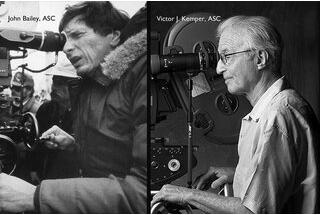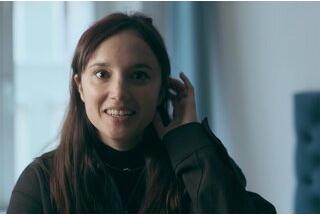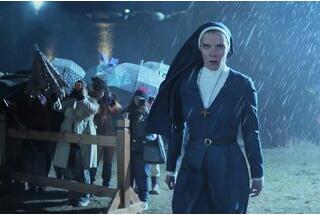Hazem Berrabah, AFC, TSC, discusses "Ashkal", by Youssef Chebbi
Concrete, cops and fireIn one of the buildings of Jardins de Carthage, a district of Tunis created by the old regime but whose construction abruptly stopped when the revolution broke out, two cops, Fatma and Batal, discover a charred corpse. As construction slowly resumes, they begin to investigate this mysterious case. When a similar incident occurs, the investigation takes a disconcerting turn.
The film opens with a series of shots without actors. It is indeed the location that starts Ashkal’s story...
Hazem Berrabah : The neighborhood of Jardins de Carthage is treated as a character in its own right in the film, as is fire. Concrete, both as matter and as geometry, dominates its inhabitants’ enigmas.
On this subject, I must mention our choice of 1.66 ratio, a format which, after several tests in preparation, seemed to us the most suitable for accompanying the characters both in their wanderings and in their confinement. Besides, Ashkal is a “camera” film, and Youssef made the choice of shot central to his directorial style.
As far as fire is concerned, we had many discussions in preparation as to the place it should occupy in the film’s color palette. To do this, we oriented the visual elements of the film (locations, props, costumes, etc.) towards a palette of cold, pastel colors, which lean towards cyan, especially on the concrete, so as to create a chromatic contrast with the fire, the only saturated element of the film. It is also in this sense that the contribution of our colorist, Emmanuel Fortin, was invaluable in refining these choices.
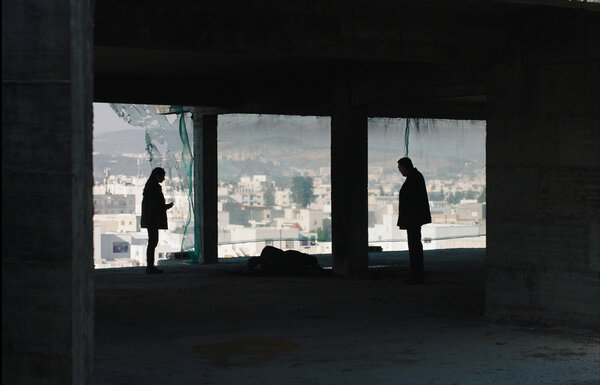
The film is also dominated by gloomy and variable weather. This is quite far removed from a sunny Mediterranean image!
HB : I believe light loss is an interesting way to bring a place to life over time, by treating it like an evolving character. The tangible movement of the shadows of the clouds is a kind of mirror of the heavy and fickle burden placed on the city. For example, the long take where Batal, the cop, goes to question the construction site guard with the containers in the background, and where his colleague Fatma then moves from the back of the shot to the foreground. During their long discussion, the sun appears in the course of the shot and causes the contrasts and colors to evolve, and this makes the location itself play a role in the action.
And then it should be noted that the film was shot in the heart of winter. Admittedly, the Tunisian winter is not very harsh, but you can that people are more heavily dressed, and the impact of the sun is lower. These cloudy atmospheres are also characteristic of this kind of “half-season”.

How many days were needed to make the film?
HB : The film was shot over thirty-six days in December 2021 and January 2022. This shows the hard work our postproduction team worked to get the film ready for Cannes, despite some VFX difficulties at the end.
Fatma Oussaifi, who plays the policewoman, is a dancer, and this was her first role on screen. Also, to make things easier for her in terms of acting, the assistant director tried as much as possible to respect the chronological order in the shooting schedule. So, we really started with the first scene and ended with the last. Between the two, a few tricks were necessary because of the many locations in the film.
How does the director, Youssef Chebbi, work?
HB : Youssef as a director is very open to visual arts, and he is a film photographer himself. This allowed us to work in a very constructive and precise way together, in particular when it came down to the shooting breakdown. In addition, he is a director who loves to question the choices we’ve made together at each stage of production, this is his way of questioning and refining things. It’s very interesting, but it wasn’t always easy given the heavy constraints of shooting on film. We were able to find solutions together, thanks to a special effort by the assistant director, in order to manage the delicate dilemma between planning in advance and leaving room for him to change his mind. I am very proud of the relationship we had together!
My only fear when starting the film was that we might perhaps lose one another artistically at one point or another during filming. It’s well known that shooting is a trial that can sometimes cause even the best ideas to get lost if the couple formed by the director and cinematographer isn’t bonded enough.
On this specific point, I must also salute the work of the producer, Fares Ladjimi, who was present every day on the set, and who never missed a single take on the monitor. Honestly, I’ve never seen this in my entire career! He created a relationship of trust and was completely transparent with the crew. He sometimes turned into a kind of artistic mirror for all of us. Fares also has excellent technical knowledge, which allowed us to adapt quickly in certain situations and make post-production decisions on set, for example.

What were your equipment choices?
HB : In the film, a good part of the night scenes took place in dark alleys in the city, under half-functioning street lights. I had neither the means nor, above all, the desire to light the city. The light of the film absolutely had to come from the ambient lighting, which was part of our approach to capturing reality. For this reason, the dual native sensitivity of the Sony Venice, offering shooting at ISO 2,500, seduced me in preparation, I wanted to test it in real-life conditions. But this camera was not available from rental companies in Tunis, and it was difficult to test without bringing it from Paris, so I finally fell back on a camera that I’m quite familiar with, the Arri Alexa.
I really like the texture that this camera offers, I’ve used it on almost all my previous films. It is also a very reassuring camera, because just with the simple basic 709 LUT, we already have a “film” rendering, while other cameras require a little more work on the look to get there. The constraint is its relative lack of sensitivity, but after screen tests, we decided to shoot the vast majority of night scenes at ISO 2,500, without it giving us cause to complain about ugly graininess. By equipping it with a Zeiss Supreme series, I found a very good compromise between the “sharpness” which is so important for concrete textures, and the softness for faces in closer shots, on which I slightly filtered with the new Schneider Radiant Soft series. Those buildings and all that weathered concrete couldn’t have worked with overly vintage lenses that would have added image texture on top of the natural dirtiness. Likewise, the Radiance series didn’t seem relevant to me because we didn’t want to play the flare card, especially on scenes with fire. In terms of focal lengths, I mainly used 40mm and 65mm on the film, with sometimes a few masters shot in 28mm, but few other focal lengths came out of the box.
In terms of lighting, I mainly used Arri SkyPanels, connected using wireless DMX to a tablet that I had with me behind the camera. On the tablet, I could instantly adjust my levels and colors myself using the “Luminair” virtual console application while looking at the image through the viewfinder. This method, inspired by the world of performing arts, and which I have been using for a few years, has allowed me to work faster and more creatively, and particularly on this film, it brought me a lot of comfort and precision.
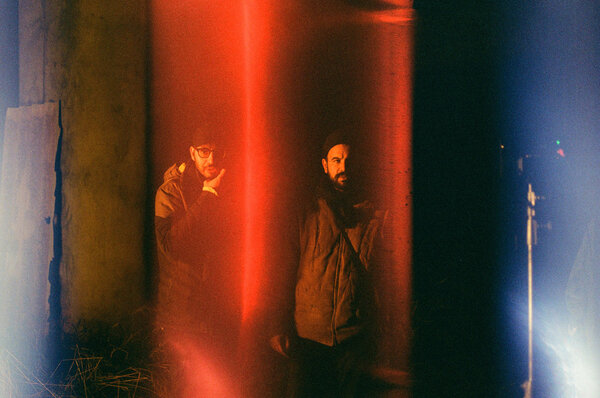
However, there is a scene in the middle of the film that stands out. A visit by the policeman character to a village hall: it is very colorful and for once much more... “oriental”!
HB : This location was one of the last to be found. When we arrived on site during our first round of location scouting, the owner showed us around exactly the way the scene takes place in the film. With, in particular the demonstration of the rather cheesy colored lights, which I filmed live with my phone. It was quite surreal, and so kitschy, that we all started laughing with Youssef.
It was clear at the time that this was absolutely not what we were looking for. And then, once we were back in the car and we rewatched the short video on the phone, Youssef and I started to say to each other, well, why not?! It goes to show that a setting completely opposite to what one imagined can sometimes serve the narration. Suddenly this very colorful, very aggressive universe seems aligned with the future to which Batal seems to aspire. Leaving the force, running away from his gray life spent in a concrete world, and moving towards something completely different. It’s an intentional aesthetic break, for the duration of a scene, which rounds out the character and serves the film.

Let’s talk a bit about the final sequence where the metaphysical aspect you mentioned takes over...
HB : For the final sequence, which of course I don’t want to give away too much about, the presence of fire is preponderant. We follow Fatma, as on other scenes, when she or Batal arrive in spaces they don’t know, using a lateral tracking shot. We liked to use this device on the film. It’s a way of allowing the viewer to discover the space, while reading the character’s expression, without having to change shot. The dolly in this scene is very important. We can clearly see Fatma’s expression, while the other characters pass her by. For the fire effect, I installed a particular device to recreate the effect of the flames, inspired (in much smaller size) by the famous nocturnal installation by Roger Deakins in the film 1917, when he lit the fire that ravaged the village center during the war. It’s a small light rig four meters high and two meters in diameter, with around thirty tungsten sources illuminating at 360° and entirely controlled by a grandMA console to imitate the random vibration of fire. This device is used in place of the inferno, and then is erased in post-production and replaced by digital flames.
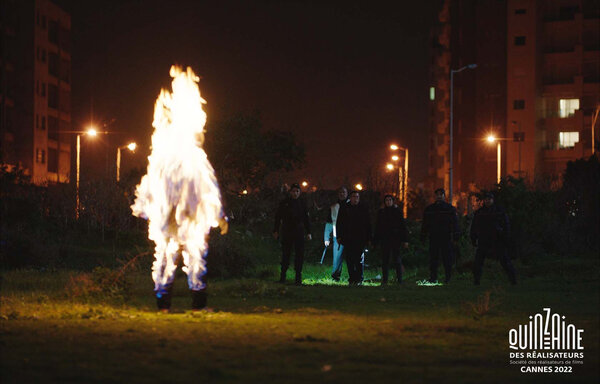
What are you most proud of in this film?
HB : Above all, I remember the unflagging dedication of a large part of the technical crew despite the difficult conditions. Climbing a dozen floors daily on foot, with equipment, in an open-air building, without railings and sometimes filming there at night, in stormy weather, at that height, was particularly risky for the technical crew. On this point in particular, I salute the courage and commitment of the grips, electricians and assistant cameramen who brilliantly accomplished their missions with extreme concentration and vigilance.
It’s in such situations, I think, that you discover how much you learn from your team, and where the simple hierarchy of the set becomes secondary. You’ve got to love your team so that they can nourish the film and not, as too often is the case, their own ego…..
Interview by François Reumont for the AFC, translated from French by Alex Baron-Raiffe
 En
En
 Fr
Fr
